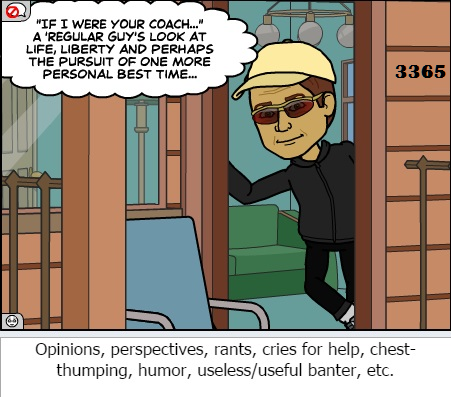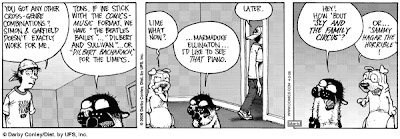 Athletic events, like life in general, are loaded with surprises. You save, you prepare, you get counsel and advice for every imaginable contingency, and boom shaka-laka (as my wife would say), something else pops up that you certainly did not expect. A water temperature that's much colder than you (or your wetsuit) can handle. A swim distance that's 200 yards longer, or rougher, than you initially suspected for the conditions. Shifting winds. One more flat tire than the number of tubes/inflator cartridges you are carrying.
Athletic events, like life in general, are loaded with surprises. You save, you prepare, you get counsel and advice for every imaginable contingency, and boom shaka-laka (as my wife would say), something else pops up that you certainly did not expect. A water temperature that's much colder than you (or your wetsuit) can handle. A swim distance that's 200 yards longer, or rougher, than you initially suspected for the conditions. Shifting winds. One more flat tire than the number of tubes/inflator cartridges you are carrying. I guess that's what makes sport - I used factors germane to triathlon, but running has it's own share of possible impossibles, such as floppy shoelaces, blisters, the severe need for a porta-john while the race is being contested, and so on, and so on - so much fun. You train, you plan your races, get your gear set up and tightened up to within an inch of its life...and life (for those of you who know John Lennon's music, I won't go further) happens.
I guess that's what makes sport - I used factors germane to triathlon, but running has it's own share of possible impossibles, such as floppy shoelaces, blisters, the severe need for a porta-john while the race is being contested, and so on, and so on - so much fun. You train, you plan your races, get your gear set up and tightened up to within an inch of its life...and life (for those of you who know John Lennon's music, I won't go further) happens. I had my moment of 'oh, my God, if I am swimming like this, how in heaven's name will I get through a swim three times the distance in three weeks?' the other weekend. However, once I got on the bike and past the first 2500 yards of the ride - about the time it takes me to realize I'm back on terra firma (and as they might say in Boston, 'the more firma the less terra') - I begin to relax and know my body and my training wouldn't necessarily let me down.
Sure, I'm a terrible swimmer. But I found I was doing much better than many of my contemporaries in the wave. I was the one pointing out dangerous situations to the rescue swimmers as I breast-stroked by. I began, at that moment on the bike, to enjoy the journey I was taking.
 It's something I didn't do last autumn as I trained for the marathon. I was so focused and fixated on that elusive goal of running in Boston in 2008 or 2009 I hadn't tapped into my own well (figuratively) to check whether my source was clear and sweet or brackish. Only in late November had I realized I was drinking from a poisoned well, so to speak. By that time it was beyond too late to fix the damage.
It's something I didn't do last autumn as I trained for the marathon. I was so focused and fixated on that elusive goal of running in Boston in 2008 or 2009 I hadn't tapped into my own well (figuratively) to check whether my source was clear and sweet or brackish. Only in late November had I realized I was drinking from a poisoned well, so to speak. By that time it was beyond too late to fix the damage.One of my athletes has finished two Ironman-distance triathlons and is presently training for a third. He's meticulous in his planning and his training. His employment, fortunately, allows him a great degree of flexibility in scheduling workouts. He's blessed with a wife who also is smart and athletic, so he has no lack of training partners. We talk on Friday evenings over beer and dinner, sometimes about travel, sometimes about sport, and sometimes we just talk. He reminded me, as I began to lay out my training plan for this spring, to enjoy the journey.
 It sounds like some sort of cop-out, especially to a guy who is used to picking up hardware at local and regional races if he's in physical and mental shape for racing. But when it comes to endurance events and multisport endurance events, if you're not an elite, the odds are very good you're going out to prove something to yourself. In the grand scheme of things, a 17-hour Ironman-distance triathlon experience is a droplet of spittle in the pool when compared to the nine months or more you'll spend training. Same thing for most marathon plans. An 18-week training build-up will probably total 800-1000 miles, all for a single-day's effort of 26.2.
It sounds like some sort of cop-out, especially to a guy who is used to picking up hardware at local and regional races if he's in physical and mental shape for racing. But when it comes to endurance events and multisport endurance events, if you're not an elite, the odds are very good you're going out to prove something to yourself. In the grand scheme of things, a 17-hour Ironman-distance triathlon experience is a droplet of spittle in the pool when compared to the nine months or more you'll spend training. Same thing for most marathon plans. An 18-week training build-up will probably total 800-1000 miles, all for a single-day's effort of 26.2. That is a lot of time for things to go right, or to go wrong. You can make it drudgery or fun. It's your choice. Odds are good the fun factor isn't going to adversely affect the outcome, so you might as well do what it takes to make the training fun. Don't judge the success or failure of the training necessarily by the outcome on race day, either. If you do that odds are plenty high you're going to be sorely disappointed.
That is a lot of time for things to go right, or to go wrong. You can make it drudgery or fun. It's your choice. Odds are good the fun factor isn't going to adversely affect the outcome, so you might as well do what it takes to make the training fun. Don't judge the success or failure of the training necessarily by the outcome on race day, either. If you do that odds are plenty high you're going to be sorely disappointed.But I bet if you look at some of the objective stuff on the way from the beginning of training to the race day, you're going to find you're tougher, stronger, faster, fitter, maybe even smarter about your body than you were before it all.

















 To get ahead in racing, the equipment you use really does make a difference. However, if you are a non-competitive type you can pretty much ignore most of the advertising material in a triathlon magazine, (I like to call it tri-geek porn) such as Triathlete, Inside Triathlon, 220, and so forth.
To get ahead in racing, the equipment you use really does make a difference. However, if you are a non-competitive type you can pretty much ignore most of the advertising material in a triathlon magazine, (I like to call it tri-geek porn) such as Triathlete, Inside Triathlon, 220, and so forth.





